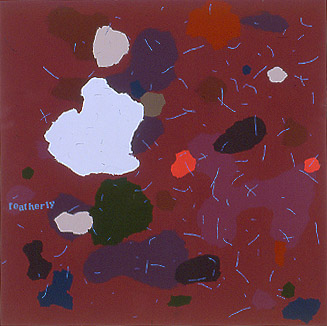Yesterday I visited Jack Featherly's studio in Williamsburg, in connection with some catalog writing we're discussing for his upcoming show at Team Gallery in NYC. His new paintings are sophisticated, dumb abstractions on large wood panels. "Dumb" because they're amorphous, solid-color blobs made with One-Shot sign-painter's enamel, blocked in with spectacularly crude, brushy edges (none of that intricate, Mark Rothko over-and-under stuff here--what Featherly brushes is pretty much what you see). "Sophisticated" because the blobs cover an underlayer, also abstract, that is selectively revealed through sharply delineated windows, created with masking-tape stencils. The stencilled shapes have a focus and precision the blobs mostly lack, although the subject matter--amoeboid ovals, looping, mock-calligraphic scribbles, molecular chains of dung-ball "atoms," and the artist's ever-present signature (rendered big, in various typebook fonts)--is ultimately just as dopey.
By combining the quest for pure form characteristic of mid-20th-Century abstraction with a cheeky graphic sensibility reminiscent of downtempo electronica packaging, Featherly manages to be sincere without being either starry-eyed or smarmy. The paintings have all the pleasure of a spontaneous "first draft" without indulging in AbEx pretensions about the meaning of same; they take the viewer into an alternate universe of hazy spectral forms without being in denial about the work's status as a "cultural product," to use the artist's term. An old-school purist like Clyfford Still might be appalled by the disjunction of tones, but as Featherly reminds us, one generation's idea of sincerity is not the same as another's. To admit a painting's connections to a stream of commerce, to "lifestyle," to the surrounding visual world of advertising and design, is generally a more honest declaration of intentions today than claiming it is somehow "apart" from such things.
|
Yesterday I visited Jack Featherly's studio in Williamsburg, in connection with some catalog writing we're discussing for his upcoming show at Team Gallery in NYC. His new paintings are sophisticated, dumb abstractions on large wood panels. "Dumb" because they're amorphous, solid-color blobs made with One-Shot sign-painter's enamel, blocked in with spectacularly crude, brushy edges (none of that intricate, Mark Rothko over-and-under stuff here--what Featherly brushes is pretty much what you see). "Sophisticated" because the blobs cover an underlayer, also abstract, that is selectively revealed through sharply delineated windows, created with masking-tape stencils. The stencilled shapes have a focus and precision the blobs mostly lack, although the subject matter--amoeboid ovals, looping, mock-calligraphic scribbles, molecular chains of dung-ball "atoms," and the artist's ever-present signature (rendered big, in various typebook fonts)--is ultimately just as dopey.
By combining the quest for pure form characteristic of mid-20th-Century abstraction with a cheeky graphic sensibility reminiscent of downtempo electronica packaging, Featherly manages to be sincere without being either starry-eyed or smarmy. The paintings have all the pleasure of a spontaneous "first draft" without indulging in AbEx pretensions about the meaning of same; they take the viewer into an alternate universe of hazy spectral forms without being in denial about the work's status as a "cultural product," to use the artist's term. An old-school purist like Clyfford Still might be appalled by the disjunction of tones, but as Featherly reminds us, one generation's idea of sincerity is not the same as another's. To admit a painting's connections to a stream of commerce, to "lifestyle," to the surrounding visual world of advertising and design, is generally a more honest declaration of intentions today than claiming it is somehow "apart" from such things.
- tom moody 1-10-2002 6:48 pm